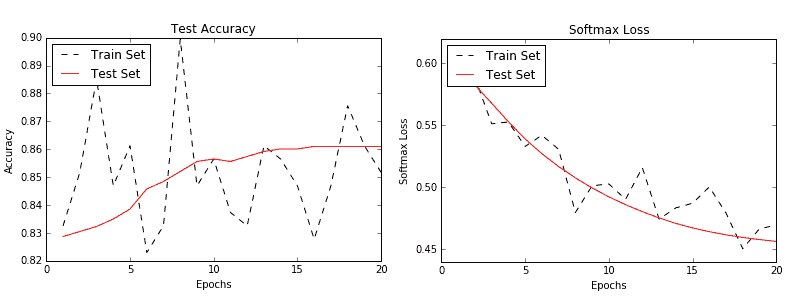# 為垃圾郵件預測實現 RNN
首先,我們將應用標準 RNN 單元來預測奇異數值輸出,即垃圾郵件概率。
## 做好準備
在此秘籍中,我們將在 TensorFlow 中實現標準 RNN,以預測短信是垃圾郵件還是火腿。我們將使用 UCI 的 ML 倉庫中的 SMS 垃圾郵件收集數據集。我們將用于預測的架構將是來自嵌入文本的輸入 RNN 序列,我們將最后的 RNN 輸出作為垃圾郵件或火腿(1 或 0)的預測。
## 操作步驟
1. 我們首先加載此腳本所需的庫:
```py
import os
import re
import io
import requests
import numpy as np
import matplotlib.pyplot as plt
import tensorflow as tf
from zipfile import ZipFile
```
1. 接下來,我們啟動圖會話并設置 RNN 模型參數。我們將通過`20`周期以`250`的批量大小運行數據。我們將考慮的每個文本的最大長度是`25`字;我們將更長的文本剪切為`25`或零填充短文本。 RNN 將是`10`單元。我們只考慮在詞匯表中出現至少 10 次的單詞,并且每個單詞都將嵌入到可訓練的大小`50`中。droupout 率將是我們可以在訓練期間`0.5`或評估期間`1.0`設置的占位符:
```py
sess = tf.Session()
epochs = 20
batch_size = 250
max_sequence_length = 25
rnn_size = 10
embedding_size = 50
min_word_frequency = 10
learning_rate = 0.0005
dropout_keep_prob = tf.placeholder(tf.float32)
```
1. 現在我們獲取 SMS 文本數據。首先,我們檢查它是否已經下載,如果是,請在文件中讀取。否則,我們下載數據并保存:
```py
data_dir = 'temp'
data_file = 'text_data.txt'
if not os.path.exists(data_dir):
os.makedirs(data_dir)
if not os.path.isfile(os.path.join(data_dir, data_file)):
zip_url = 'http://archive.ics.uci.edu/ml/machine-learning-databases/00228/smsspamcollection.zip'
r = requests.get(zip_url)
z = ZipFile(io.BytesIO(r.content))
file = z.read('SMSSpamCollection')
# Format Data
text_data = file.decode()
text_data = text_data.encode('ascii',errors='ignore')
text_data = text_data.decode().split('\n')
# Save data to text file
with open(os.path.join(data_dir, data_file), 'w') as file_conn:
for text in text_data:
file_conn.write("{}\n".format(text))
else:
# Open data from text file
text_data = []
with open(os.path.join(data_dir, data_file), 'r') as file_conn:
for row in file_conn:
text_data.append(row)
text_data = text_data[:-1]
text_data = [x.split('\t') for x in text_data if len(x)>=1]
[text_data_target, text_data_train] = [list(x) for x in zip(*text_data)]
```
1. 為了減少我們的詞匯量,我們將通過刪除特殊字符和額外的空格來清理輸入文本,并將所有內容放在小寫中:
```py
def clean_text(text_string):
text_string = re.sub(r'([^sw]|_|[0-9])+', '', text_string)
text_string = " ".join(text_string.split())
text_string = text_string.lower()
return text_string
# Clean texts
text_data_train = [clean_text(x) for x in text_data_train]
```
> 請注意,我們的清潔步驟會刪除特殊字符作為替代方案,我們也可以用空格替換它們。理想情況下,這取決于數據集的格式。
1. 現在我們使用 TensorFlow 的內置詞匯處理器函數處理文本。這會將文本轉換為適當的索引列表:
```py
vocab_processor = tf.contrib.learn.preprocessing.VocabularyProcessor(max_sequence_length, min_frequency=min_word_frequency)
text_processed = np.array(list(vocab_processor.fit_transform(text_data_train)))
```
> 請注意,`contrib.learn.preprocessing`中的函數目前已棄用(使用當前的 TensorFlow 版本,1.10)。目前的替換建議 TensorFlow 預處理包僅在 Python 2 中運行。將 TensorFlow 預處理移至 Python 3 的工作目前正在進行中,并將取代前兩行。請記住,所有當前和最新的代碼都可以在這個 GitHub 頁面找到: [https://www.github.com/nfmcclure/tensorflow_cookbook](https://www.github.com/nfmcclure/tensorflow_cookbook) 和 Packt 倉庫: [https:/ /github.com/PacktPublishing/TensorFlow-Machine-Learning-Cookbook-Second-Edition](https://github.com/PacktPublishing/TensorFlow-Machine-Learning-Cookbook-Second-Edition) 。
1. 接下來,我們將數據隨機化以使其隨機化:
```py
text_processed = np.array(text_processed)
text_data_target = np.array([1 if x=='ham' else 0 for x in text_data_target])
shuffled_ix = np.random.permutation(np.arange(len(text_data_target)))
x_shuffled = text_processed[shuffled_ix]
y_shuffled = text_data_target[shuffled_ix]
```
1. 我們還將數據拆分為 80-20 訓練測試數據集:
```py
ix_cutoff = int(len(y_shuffled)*0.80)
x_train, x_test = x_shuffled[:ix_cutoff], x_shuffled[ix_cutoff:]
y_train, y_test = y_shuffled[:ix_cutoff], y_shuffled[ix_cutoff:]
vocab_size = len(vocab_processor.vocabulary_)
print("Vocabulary Size: {:d}".format(vocab_size))
print("80-20 Train Test split: {:d} -- {:d}".format(len(y_train), len(y_test)))
```
> 對于這個秘籍,我們不會進行任何超參數調整。如果讀者朝這個方向前進,請記住在繼續之前將數據集拆分為訓練測試驗證集。一個很好的選擇是 Scikit-learn 函數`model_selection.train_test_split()`。
1. 接下來,我們聲明圖占位符。 `x`輸入將是一個大小為`[None, max_sequence_length]`的占位符,它將是根據文本消息允許的最大字長的批量大小。對于火腿或垃圾郵件,`y` -output 占位符只是一個 0 或 1 的整數:
```py
x_data = tf.placeholder(tf.int32, [None, max_sequence_length])
y_output = tf.placeholder(tf.int32, [None])
```
1. 我們現在為`x`輸入數據創建嵌入矩陣和嵌入查找操作:
```py
embedding_mat = tf.Variable(tf.random_uniform([vocab_size, embedding_size], -1.0, 1.0))
embedding_output = tf.nn.embedding_lookup(embedding_mat, x_data)
```
1. 我們將模型聲明如下。首先,我們初始化一種要使用的 RNN 小區(RNN 大小為 10)。然后我們通過使其成為動態 RNN 來創建 RNN 序列。然后我們將退出添加到 RNN:
```py
cell = tf.nn.rnn_cell.BasicRNNCell(num_units = rnn_size)
output, state = tf.nn.dynamic_rnn(cell, embedding_output, dtype=tf.float32)
output = tf.nn.dropout(output, dropout_keep_prob)
```
> 注意,動態 RNN 允許可變長度序列。即使我們在這個例子中使用固定的序列長度,通常最好在 TensorFlow 中使用`dynamic_rnn`有兩個主要原因。一個原因是,在實踐中,動態 RNN 實際上運行速度更快;第二個是,如果我們選擇,我們可以通過 RNN 運行不同長度的序列。
1. 現在要得到我們的預測,我們必須重新安排 RNN 并切掉最后一個輸出:
```py
output = tf.transpose(output, [1, 0, 2])
last = tf.gather(output, int(output.get_shape()[0]) - 1)
```
1. 為了完成 RNN 預測,我們通過完全連接的網絡層將`rnn_size`輸出轉換為兩個類別輸出:
```py
weight = tf.Variable(tf.truncated_normal([rnn_size, 2], stddev=0.1))
bias = tf.Variable(tf.constant(0.1, shape=[2]))
logits_out = tf.nn.softmax(tf.matmul(last, weight) + bias)
```
1. 我們接下來宣布我們的損失函數。請記住,當使用 TensorFlow 中的`sparse_softmax`函數時,目標必須是整數索引(類型為`int`),并且 logits 必須是浮點數:
```py
losses = tf.nn.sparse_softmax_cross_entropy_with_logits(logits=logits_out, labels=y_output)
loss = tf.reduce_mean(losses)
```
1. 我們還需要一個精確度函數,以便我們可以比較測試和訓練集上的算法:
```py
accuracy = tf.reduce_mean(tf.cast(tf.equal(tf.argmax(logits_out, 1), tf.cast(y_output, tf.int64)), tf.float32))
```
1. 接下來,我們創建優化函數并初始化模型變量:
```py
optimizer = tf.train.RMSPropOptimizer(learning_rate)
train_step = optimizer.minimize(loss)
init = tf.global_variables_initializer()
sess.run(init)
```
1. 現在我們可以開始循環遍歷數據并訓練模型。在多次循環數據時,最好在每個周期對數據進行洗牌以防止過度訓練:
```py
train_loss = []
test_loss = []
train_accuracy = []
test_accuracy = []
# Start training
for epoch in range(epochs):
# Shuffle training data
shuffled_ix = np.random.permutation(np.arange(len(x_train)))
x_train = x_train[shuffled_ix]
y_train = y_train[shuffled_ix]
num_batches = int(len(x_train)/batch_size) + 1
for i in range(num_batches):
# Select train data
min_ix = i * batch_size
max_ix = np.min([len(x_train), ((i+1) * batch_size)])
x_train_batch = x_train[min_ix:max_ix]
y_train_batch = y_train[min_ix:max_ix]
# Run train step
train_dict = {x_data: x_train_batch, y_output: y_train_batch, dropout_keep_prob:0.5}
sess.run(train_step, feed_dict=train_dict)
# Run loss and accuracy for training
temp_train_loss, temp_train_acc = sess.run([loss, accuracy], feed_dict=train_dict)
train_loss.append(temp_train_loss)
train_accuracy.append(temp_train_acc)
# Run Eval Step
test_dict = {x_data: x_test, y_output: y_test, dropout_keep_prob:1.0}
temp_test_loss, temp_test_acc = sess.run([loss, accuracy], feed_dict=test_dict)
test_loss.append(temp_test_loss)
test_accuracy.append(temp_test_acc)
print('Epoch: {}, Test Loss: {:.2}, Test Acc: {:.2}'.format(epoch+1, temp_test_loss, temp_test_acc))
```
1. 這導致以下輸出:
```py
Vocabulary Size: 933
80-20 Train Test split: 4459 -- 1115
Epoch: 1, Test Loss: 0.59, Test Acc: 0.83
Epoch: 2, Test Loss: 0.58, Test Acc: 0.83
...
```
```py
Epoch: 19, Test Loss: 0.46, Test Acc: 0.86
Epoch: 20, Test Loss: 0.46, Test Acc: 0.86
```
1. 以下是繪制訓練/測試損失和準確率的代碼:
```py
epoch_seq = np.arange(1, epochs+1)
plt.plot(epoch_seq, train_loss, 'k--', label='Train Set')
plt.plot(epoch_seq, test_loss, 'r-', label='Test Set')
plt.title('Softmax Loss')
plt.xlabel('Epochs')
plt.ylabel('Softmax Loss')
plt.legend(loc='upper left')
plt.show()
# Plot accuracy over time
plt.plot(epoch_seq, train_accuracy, 'k--', label='Train Set')
plt.plot(epoch_seq, test_accuracy, 'r-', label='Test Set')
plt.title('Test Accuracy')
plt.xlabel('Epochs')
plt.ylabel('Accuracy')
plt.legend(loc='upper left')
plt.show()
```
## 工作原理
在這個秘籍中,我們創建了一個 RNN 到類別的模型來預測 SMS 文本是垃圾郵件還是火腿。我們在測試裝置上實現了大約 86%的準確率。以下是測試和訓練集的準確率和損失圖:

圖 3:訓練和測試集的準確率(左)和損失(右)
## 更多
強烈建議您多次瀏覽訓練數據集以獲取順序數據(這也建議用于非順序數據)。每次傳遞數據都稱為周期。此外,在每個周期之前對數據進行混洗是非常常見的(并且強烈推薦),以最小化數據順序對訓練的影響。
- TensorFlow 入門
- 介紹
- TensorFlow 如何工作
- 聲明變量和張量
- 使用占位符和變量
- 使用矩陣
- 聲明操作符
- 實現激活函數
- 使用數據源
- 其他資源
- TensorFlow 的方式
- 介紹
- 計算圖中的操作
- 對嵌套操作分層
- 使用多個層
- 實現損失函數
- 實現反向傳播
- 使用批量和隨機訓練
- 把所有東西結合在一起
- 評估模型
- 線性回歸
- 介紹
- 使用矩陣逆方法
- 實現分解方法
- 學習 TensorFlow 線性回歸方法
- 理解線性回歸中的損失函數
- 實現 deming 回歸
- 實現套索和嶺回歸
- 實現彈性網絡回歸
- 實現邏輯回歸
- 支持向量機
- 介紹
- 使用線性 SVM
- 簡化為線性回歸
- 在 TensorFlow 中使用內核
- 實現非線性 SVM
- 實現多類 SVM
- 最近鄰方法
- 介紹
- 使用最近鄰
- 使用基于文本的距離
- 使用混合距離函數的計算
- 使用地址匹配的示例
- 使用最近鄰進行圖像識別
- 神經網絡
- 介紹
- 實現操作門
- 使用門和激活函數
- 實現單層神經網絡
- 實現不同的層
- 使用多層神經網絡
- 改進線性模型的預測
- 學習玩井字棋
- 自然語言處理
- 介紹
- 使用詞袋嵌入
- 實現 TF-IDF
- 使用 Skip-Gram 嵌入
- 使用 CBOW 嵌入
- 使用 word2vec 進行預測
- 使用 doc2vec 進行情緒分析
- 卷積神經網絡
- 介紹
- 實現簡單的 CNN
- 實現先進的 CNN
- 重新訓練現有的 CNN 模型
- 應用 StyleNet 和 NeuralStyle 項目
- 實現 DeepDream
- 循環神經網絡
- 介紹
- 為垃圾郵件預測實現 RNN
- 實現 LSTM 模型
- 堆疊多個 LSTM 層
- 創建序列到序列模型
- 訓練 Siamese RNN 相似性度量
- 將 TensorFlow 投入生產
- 介紹
- 實現單元測試
- 使用多個執行程序
- 并行化 TensorFlow
- 將 TensorFlow 投入生產
- 生產環境 TensorFlow 的一個例子
- 使用 TensorFlow 服務
- 更多 TensorFlow
- 介紹
- 可視化 TensorBoard 中的圖
- 使用遺傳算法
- 使用 k 均值聚類
- 求解常微分方程組
- 使用隨機森林
- 使用 TensorFlow 和 Keras
